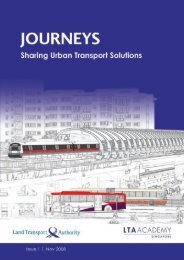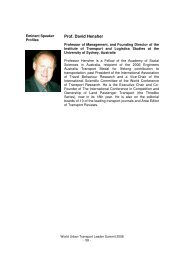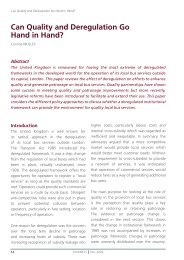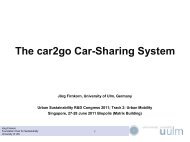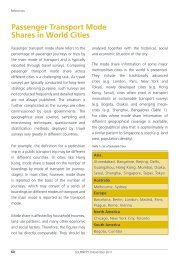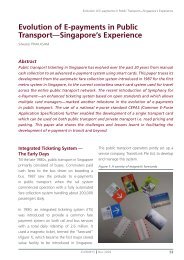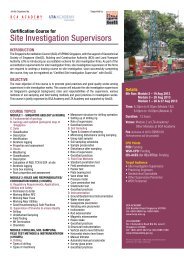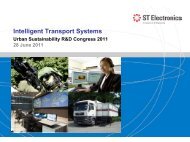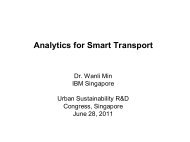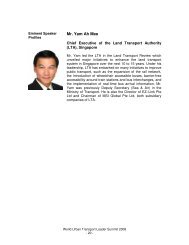Full Version - Issue 7 | November 2011 - LTA Academy
Full Version - Issue 7 | November 2011 - LTA Academy
Full Version - Issue 7 | November 2011 - LTA Academy
Create successful ePaper yourself
Turn your PDF publications into a flip-book with our unique Google optimized e-Paper software.
costs, public transport, especially in local<br />
urban contexts, can be considered a natural<br />
monopoly with significant economies of scale.<br />
This means that one large operator can supply<br />
public transport services at lower costs than<br />
two or more smaller operators.<br />
Due to the high fixed costs relative<br />
to operating costs, public transport,<br />
especially in local urban contexts, can<br />
be considered a natural monopoly<br />
with significant economies of scale.<br />
This means that one large operator<br />
can supply public transport services<br />
at lower costs than two or more<br />
smaller operators.<br />
While there are potential benefits, there are<br />
also risks associated with privatisation. Basic<br />
economic theory warns of the dangers of<br />
monopoly, public or private. Driven by the profit<br />
motive, private monopolies could exploit their<br />
market power to charge much higher prices<br />
than would have been possible with market<br />
competition. They may also reduce costs by<br />
lowering service levels, such as reducing service<br />
frequencies and equipment maintenance<br />
levels. An effective regulatory framework with<br />
price control must be in place to ensure that<br />
monopoly exploitation does not occur.<br />
Different Approaches to Public<br />
Transport Provision<br />
Government Operators<br />
Some would argue that, since private<br />
monopolies are likely to abuse their market<br />
power, it would be preferable to nationalise<br />
public transport. Nationalisation can be<br />
defined in several ways, for example, it could<br />
mean the government taking over transport<br />
planning, ownership of infrastructure, or<br />
service provision. In this article, nationalisation<br />
is defined specifically as government provision<br />
of public transport services.<br />
Proponents believe that government-run public<br />
transport operators which are not profit-driven<br />
would be less likely to abuse their market power,<br />
and would place greater priority on public<br />
service objectives, such as affordable fares and<br />
service enhancement. The government would<br />
also have more direct control over fares, supply<br />
of services, and service quality.<br />
However the lack of a profit motive provides<br />
little incentive for government operators to<br />
be efficient. While it is possible to set clear<br />
performance objectives for public enterprises,<br />
the experience in several countries has shown<br />
that government operators have generally<br />
failed to operate efficiently and their unit costs<br />
have increased steadily over the years. They<br />
would also face greater political pressure to<br />
provide unprofitable services.<br />
A benchmarking study done in 2008 compared<br />
Sydney’s government-run rail operator CityRail<br />
with Melbourne’s private rail operator Connex<br />
(LEK 2008). Both operators were comparable in<br />
scale but there was a disparity in cost efficiency.<br />
Using data from 2006/7, the study found that<br />
Connex’s costs were lower than CityRail’s.<br />
Connex’s annual rolling stock costs were 40%<br />
JOURNEYS | <strong>November</strong> <strong>2011</strong><br />
Different Approaches to Public Transport Provision<br />
Some would argue that, since private<br />
monopolies are likely to abuse their<br />
market power, it would be preferable<br />
to nationalise public transport.<br />
33



